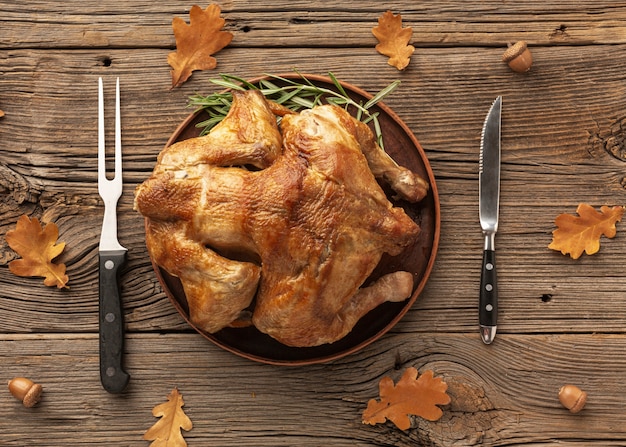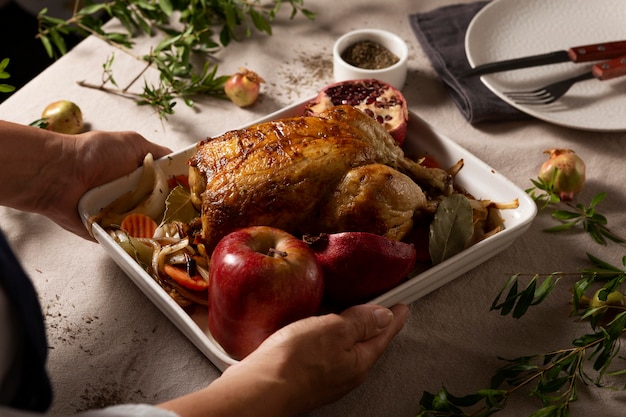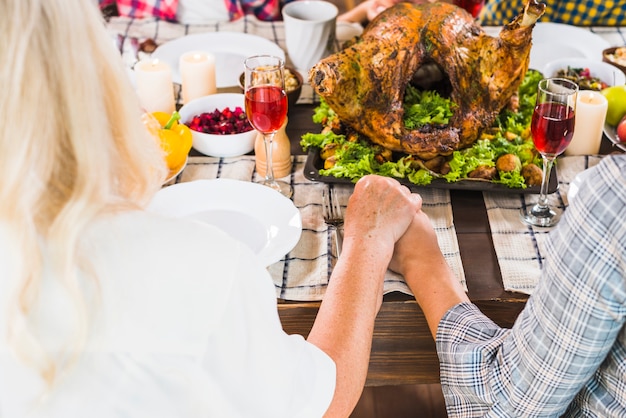Ah, the Christmas turkey. A beautiful, golden-brown centerpiece, promising a feast for family and friends. But let's be honest, the thought of cooking a 20lb turkey can be a bit daunting. How long do you roast it for? Will it be juicy or dry as a bone? Don't worry, I'm here to help! I've been tackling turkeys for years, and I've learned a thing or two about getting them perfectly cooked. This guide will walk you through everything you need to know, from basic tips to insider tricks.
(Part 1) The Basics - Setting the Stage

Understanding the Challenge
A 20lb turkey is a serious commitment. It's not like throwing a chicken in the oven for dinner. This is a big bird, and it needs proper attention. The good news is, with a little planning and knowledge, you can conquer the challenge and serve up a delicious, perfectly cooked turkey.
The Importance of Temperature
Let's get one thing straight: the key to a safe and delicious turkey is reaching the correct internal temperature. We're aiming for 165°F (74°C). This ensures the bird is cooked through and safe to eat. You can't judge by appearance alone. A meat thermometer is a must-have tool, and I highly recommend using it throughout the cooking process. It'll save you from any culinary disasters.
(Part 2) Time to Roast - Getting Started

Estimating Cooking Time
For a 20lb turkey, you're looking at a roasting time of approximately 3.5-4 hours at 325°F (165°C). But remember, this is just a starting point. Every turkey is unique, so you'll need to factor in individual differences.
What Affects Cooking Time
Here are some factors that can influence the time your turkey needs in the oven:
- Size: Larger turkeys take longer to cook through. A 20lb bird is a big one, so be prepared for a longer roasting time compared to a smaller bird.
- Shape: A turkey with a lot of breast meat might need a bit more time than one with a lot of leg meat, as the breast meat tends to take a bit longer to cook through.
- Oven Temperature: Higher temperatures cook the turkey faster, but they also increase the risk of drying it out. 325°F (165°C) is the ideal temperature for most turkeys.
- Stuffing: Stuffing your turkey adds an extra layer of complexity. The stuffing needs to reach 165°F (74°C) as well, which means it will take longer to cook. If you're stuffing your turkey, be prepared to add extra time.
(Part 3) Calculating the Right Time - No Guesswork

The Rule of Thumb - A Starting Point
There's a classic rule of thumb: allow 15 minutes per pound for a turkey at 325°F (165°C). For a 20lb bird, that works out to be 300 minutes, or 5 hours. This is a good starting point, but don't forget to factor in the resting time, which adds another 30 minutes.
Cooking Time Chart - A Quick Reference
Here's a handy table to help you estimate the cooking time for various turkey weights:
| Turkey Weight (lbs) | Cooking Time (325°F) |
|---|---|
| 10-12 | 2-2.5 hours |
| 12-14 | 2.5-3 hours |
| 14-16 | 3-3.5 hours |
| 16-18 | 3.5-4 hours |
| 18-20 | 4-4.5 hours |
Meat Thermometer - Your Trusted Companion
Remember, the most important tool in your arsenal is a meat thermometer. It's the only way to be absolutely sure your turkey is cooked through. Insert the thermometer into the thickest part of the thigh, away from any bone. When it reads 165°F (74°C), your turkey is ready to be taken out of the oven.
(Part 4) The Secret to juicy turkey - Beyond Time
Brining - The Secret Weapon
We all know the horror of a dry, overcooked turkey. That's where brining comes in. Think of it as a spa treatment for your turkey. By soaking it in a salt water solution for a few hours or overnight, you rehydrate the meat, making it incredibly juicy and tender. This step is absolutely worth the extra effort!
Other Tips for Juicy Turkey - Going the Extra Mile
Even without brining, there are ways to boost your turkey's moisture and flavor:
- Basting: Regularly basting the turkey with its own pan drippings helps keep it moist and adds flavor. This is a simple but effective technique.
- Tenting with Foil: Towards the end of cooking, cover the turkey with foil. This prevents the skin from getting too crispy and helps retain moisture.
- Resting Time: Don't rush to carve the turkey right away. Let it rest for 30 minutes after coming out of the oven. This allows the juices to redistribute, resulting in a much juicier and more flavorful bird.
(Part 5) The Big Day - Roasting Time
Prepping for Perfection
Let's get this turkey ready for the oven! Start by taking it out of the refrigerator and letting it sit at room temperature for about an hour. This ensures it cooks evenly. Then, pat the turkey dry with paper towels. Next, rub it with olive oil or butter to help create a crispy skin.
Stuffing - A Matter of Taste
Stuffing is a personal choice. Some love the traditional stuffed turkey, while others prefer to cook the stuffing separately. If you're going the stuffed route, make sure to cook the stuffing to an internal temperature of 165°F (74°C). Stuff the turkey loosely and don't overfill it, allowing the stuffing to cook evenly.
Placement in the Oven - Strategic Positioning
Place your prepped turkey in a roasting pan and put it in the middle of the oven. Leave some space around it for air circulation. This ensures even cooking and prevents any hot spots.
(Part 6) Monitoring the Roast - Stay Alert
Temperature Check - The Key Indicator
Now comes the crucial part: monitoring the temperature. Use your trusty meat thermometer to check the internal temperature of the turkey in the thickest part of the thigh, away from any bone. It should reach 165°F (74°C). If you're stuffing, make sure the stuffing reaches that temperature as well.
Resting Time - Crucial for Juiciness
Once your turkey is cooked through, take it out of the oven and let it rest for about 30 minutes before carving. This allows the juices to redistribute, resulting in a truly succulent turkey.
(Part 7) Carving Time - A Triumphant Moment
carving a turkey can seem intimidating, but it's really not that difficult. Start by removing the legs and thighs. Then, separate the breast from the carcass. Use a sharp knife to carve the breast meat into slices. Be careful not to shred the meat.
(Part 8) Leftovers - Don't Waste a Bit
Leftover turkey? Absolutely! It's a culinary treasure. Use it to make sandwiches, salads, soups, or even pies. Just be sure to refrigerate the leftovers within two hours of cooking.
FAQs - Answering Your Questions
1. Can I Cook a Turkey at a Lower Temperature?
Yes, you can. cooking a turkey at a lower temperature, like 300°F (150°C), will take longer (about 5-6 hours), but it will result in a more moist turkey. Experiment and see what works best for you. Just remember to adjust the cooking time accordingly.
2. What if My Turkey Isn't Fully Cooked?
If your turkey hasn't reached the desired internal temperature, don't panic! Simply return it to the oven and continue cooking until it reaches 165°F (74°C). Make sure to check the stuffing temperature as well if you've stuffed the turkey.
3. Can I Freeze a Cooked Turkey?
Yes, you can! Wrap the cooked turkey tightly in plastic wrap and aluminum foil, and freeze for up to 2 months. When ready to use, defrost the turkey in the refrigerator before reheating.
4. What if My Turkey is Too Dry?
If your turkey is a bit dry, there are ways to remedy it. Add some gravy or sauce to boost moisture. Alternatively, use the leftover turkey to make a hearty soup or stew.
5. What if I Don't Have a Meat Thermometer?
While a meat thermometer is the most accurate way to gauge doneness, there are other methods you can use. The turkey juices should run clear, and the skin should be golden brown. However, it's always a good idea to invest in a meat thermometer for peace of mind.
There you have it! With a bit of planning and these tips, you'll be well on your way to a perfectly cooked, juicy, and delicious turkey. Happy holidays!
Everyone is watching

How to Cook Frozen Lobster Tails Perfectly: A Step-by-Step Guide
RecipesLobster. Just the word conjures up images of lavish meals, special occasions, and a taste of luxury. But let's...

Pigs in a Blanket Cooking Time: How Long to Bake for Perfect Results
RecipesAh, pigs in a blanket. Just the name conjures up images of those delightful little parcels of crispy pastry en...

Pork Fillet Cooking Time: How Long to Cook It Perfectly
RecipesPork fillet, or tenderloin as it's sometimes called, is a real favourite in our house. It's so versatile, and...

The Ultimate Guide to Cooking Delicious Frankfurters
RecipesLet's face it, we all love a good frankfurter. It's a classic, simple, and always satisfying. But let's be rea...

The Ultimate Guide to Tender, Juicy Pulled Pork
RecipesRight, let's talk pulled pork. It's one of those dishes that just screams "comfort food," doesn't it? I mean...
